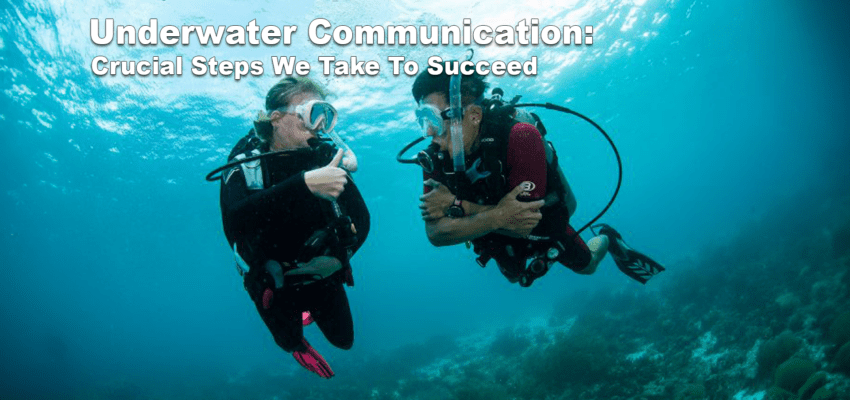In the enchanting world of underwater filmmaking, the significance of communication
takes center stage. With over 30 years of industry experience, we appreciate that
effective communication is not only desirable but indispensable in underwater
cinematography. This blog post dives deep into the ways underwater camera operators
communicate to show you what goes on below the surface.
The Importance of Communication on Set
Regular communication on a film set is not only normal, but necessary. The following
areas are some of the reasons why effective communication is so important:
- Collaborations: There are numerous professionals involved in filmmaking: talent, camera operators, directors, and producers to name a few. Each department must coordinate and align to achieve the goals of production.
- Adjustments: Whether it is due to lighting, weather, or problems on set, there are many on-the-fly adjustments made during production. This necessitates updates to all professionals involved.
- Direction: One of the camera operator’s role in underwater filmmaking involves translating the director’s vision into achievable actions for talent.
- Problem-Solving: The camera operator employs hand signals to relay information to the above-water camera technician, facilitating the swift transmission of underwater conditions to the entire crew.
- Safety and Logistics: Filming underwater can become hazardous if there are no experts around to help. Communication throughout production helps maintain safety and ensure everyone is on the same page before shooting.
Unique Ways to Communicate Underwater
There are many challenges that filmmakers face when communicating underwater.
Since they cannot talk to each other naturally, they have to figure out ways to convey
what they need. Below are some ways they do this:
Underwater PA System
We use a Hydrophone to communicate to everyone underwater at once. It is an ideal system for a pool when the topside Director needs to communicate one-way to the underwater camera operator and/or talent during a shoot. The Hydrophone is calibrated for the sound waves to travel through water rather than air. When the director speaks into the microphone, anyone in the pool can hear what they are saying.
Setting up a PA system is quick, enhances communication, ensures clear directives for talent, streamlines production flow, and reduces time spent underwater.
Communication System
A communication system, like the OTS Aquacom MK2-DC1, is ideal for underwater talent communications in a live broadcast situation. Up to four divers can communicate to a topside tender via a four wire mask system with ComRope. This system is beneficial if for longer underwater productions or if you want to make many changes to your shots. The camera operator can speak directly to the talent underwater and to the topside director and camera technician.
Hand Signals
Since a PA system only works one-way, from topside to underwater, hand signals are used between the underwater operator and the topside technician. The operator can alert the technician quickly and efficiently if they are ready to shoot or if they need production to wait.
The Professional Association of Diving Instructors has a standardized set of hand signals that we utilize. The ones we use most often are:
- Ascend, which is a thumbs up.
- Descend, which is a thumbs down.
- Are you OK?/I am OK which is a circle made with your thumb and forefinger with all remaining fingers extended upward.
The operator will inform talent what the signals mean and what to do if they see them.
This helps keep everyone safe and on the same page.
The Consequences of Miscommunication
If underwater communication systems are not set up, you can run into a number of issues. If talent cannot hear direction, they cannot adjust on the fly. If the operator cannot hear direction, they might:
- start rolling too early
- stop rolling before the director calls cut
- continue rolling when everyone else has cut
- frame a different shot than what the director wants
All of these issues add time to production.
Pre-Production Planning
Preparing for effective communication happens long before you arrive to set. When you hire an expert, we help you decide which type of communication system will work best for your situation.
Having the right equipment and expertise contributes to effective communication on set. If you’re shooting in a pool, we recommend using a PA system. If you’re shooting in open water, using comms and hand signals become even more important.
When we’re on set, we establish ground rules of how to communicate using the systems so everyone has context for the framework we work within. This ensures everyone is informed about upcoming actions, eliminating guesswork and reducing on-set confusion and time.
Diving In?
In the world of underwater filmmaking, clear communication goes a long way. From PA systems to communication devices, these innovations enhance clarity and streamline production, while minimizing costly delays and misaligned shots.
Comprehensive pre-production planning can help you choose the right communication system and establish clear communication protocols to ensure your underwater shoot goes off without a hitch.
With over three decades of industry experience, we’re happy to help with your next
underwater adventure. You can contact our team for more information via:
Website: airsealand.com
Telephone: +1 (718) 626.2646
Email: info@airsealand.com or rentals@airsealand.com



